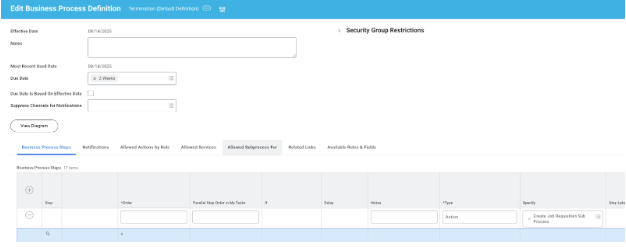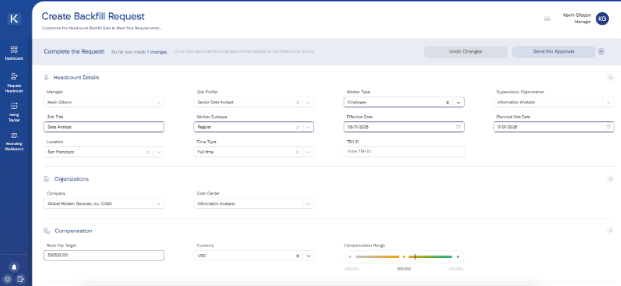Workday Terminations: Automate Backfills for Streamlined Position Management
You’ve probably dealt with this scenario in the last few months: An employee terminates, and someone processing the Workday termination sees that dreaded "Close Position" checkbox. Do they check it? Leave it unchecked? Who decides if this role gets backfilled or eliminated? This simple field creates chaos across Finance, HR, and Recruiting teams overseeing the headcount management process.
Workday position management during a termination can create severe downstream implications because position closure decisions are often made by an initiator without the authority or context to make the right choice. The person entering the Workday termination data isn't necessarily the budget (or process) owner who should decide whether to backfill the position, split it, re-allocate it, or close it.
When termination processing lacks proper governance, positions disappear from workforce planning, backfill decisions get made accidentally, and Finance loses visibility into headcount changes. But with the right approach and tools like comprehensive headcount management software, termination processing becomes a streamlined, automated workflow that actually supports your Workday headcount management strategy.
The Termination Processing Complexity Trap
The most common headcount management mistake organizations make when it comes to Workday terminations is allowing anyone with Workday termination initiator access to close positions during the termination process. Here's what typically happens: A manager terminates an employee and sees the "close position" field. Without clear guidance, they might close it assuming the role is eliminated, or leave it open thinking someone else will decide later. This leads to a host of problems.
Immediate Reconciliation Nightmares for HR Teams
Finance pulls reports showing open positions that should have been closed, or discovers closed positions that were supposed to be backfilled. HR Operations spends hours manually reviewing terminated employees to determine which positions need action, often weeks after the fact when hiring timelines have already been compromised.
Inaccurate Workforce Planning
Position closure decisions during terminations directly impact workforce planning accuracy. When a position gets closed in Workday, it disappears from Finance's open position reports, meaning they lose visibility into potential backfill costs. If the role should have been backfilled, Finance can't budget for it because it no longer exists in their planning systems or in Workday.
Increased Complexity with Multiple Stakeholders
The complexity multiplies when backfill decisions involve multiple stakeholders. The manager processing the termination might not know the budget implications, the Finance team might not understand the operational impact, and Recruiting needs to know immediately whether to start sourcing candidates. Without clear processes, these decisions happen in silos or not at all.
4 Steps to Streamline Workday Termination Processing and Backfills
The optimal configuration prevents position closure confusion by removing the decision from the Workday termination process entirely. Configure your termination business process definition to include a validation rule that either prevents position closure completely or requires it based on your organizational policy.
1. Add a Validation Rule on the Termination Business Process Initiation
Create a validation condition rule that triggers when someone attempts to close a position during Workday termination. The rule should display an error message that prevents submission, such as "Position closure decisions must be made through the designated backfill position review process, not during termination processing."
Here’s an example of the validation condition rule:
For organizations that want to enforce position closure during every termination, reverse the validation rule to require the "close position" field to be checked. This ensures consistency but requires a separate process for handling backfill position decisions before terminations are processed.
Notice the error that disallows the user from closing the position:
2. Implement Automated Backfill Workflows Using Workday's Job Requisition Sub-Process
Next, configure an allowable sub-process on termination that automatically creates a job requisition against the existing position when someone terminates. This kicks off recruiting immediately while maintaining the position for workforce planning purposes.
3. Establish Clear Governance Around Who Can Make Position Closure Decisions
Limit Workday termination processing access to HR Partners (or a clearly defined owner within the organization) while giving budget owners and department heads separate workflows for position closure and backfill position decisions. This separates the administrative task of processing terminations from the strategic decisions about Workday position management and your overall headcount management process.
4. Create Regular Position Reconciliation Reporting
Finally, set up automated reports that show terminated employees whose positions remain open. This allows Finance and HR teams to review backfill position decisions systematically rather than reactively.
The key is removing Workday position management decisions from the urgent, administrative task of processing terminations and creating intentional workflows for workforce planning decisions.
Streamline and Automate Complex Termination Processing with Intuitive Headcount Management Software
Using the right tools can make all the difference in how easy or chaotic backfills are for your organization. Our intuitive headcount management software Kinnect eliminates the Workday termination processing complexity by automatically detecting when employees terminate in Workday and presenting backfill position decisions through intuitive workflows rather than confusing checkboxes during administrative processes.
Intelligent Position Status Management
When a Workday termination happens, Kinnect automatically ingests this data and moves the position to our backfill tab in the hiring tracker. This removes the position closure decision from the termination process entirely—whoever processes the termination in Workday doesn't need to make Workday position management decisions they're not qualified to make.
Automated Backfill Decision Workflows
Managers and budget owners receive notifications about terminated employees through our streamlined headcount management software interface, where they can review the role, assess business needs, and choose to either request a backfill position or close the position. Even if the termination is future-dated, recruiting can begin immediately without waiting for Workday approvals or workflows to complete.
Elimination of Manual Reconciliation Work & Immediate ROI
Kinnect's approach completely eliminates the reconciliation nightmares that plague traditional Workday termination processing. Instead of HR teams spending hours reviewing terminated employees to determine position status, our headcount management software automatically routes each termination to the appropriate decision-maker with all the context they need.
Our backfill position workflow decouples position management from worker data. That means:
Position closure decisions happen with full visibility into budget impact, team structure, and business needs
Finance maintains complete visibility into all position changes through our real-time reporting
Recruiting gets immediate clarity on which roles need to be filled
The result is Workday position management that transforms terminations from chaotic administrative tasks into strategic workforce planning opportunities, all while maintaining perfect data integrity and eliminating manual reconciliation work. And the ROI is immediate. Organizations:
See a 70% reduction in time spent on termination-related position management tasks
Eliminate costly hiring delays from unclear decisions
Free up HR teams to focus on strategic initiatives instead of administrative cleanup
You Can Transform Your Termination Processing from Complex to Easy
Workday termination processing doesn't have to create organizational chaos or endless reconciliation work. The most successful organizations recognize that complexity stems from forcing Workday position management decisions into administrative workflows where they don't belong. When you separate the urgent task of processing terminations from strategic backfill position decisions, terminations become opportunities for intentional workforce planning rather than sources of confusion.
Kinnect's headcount management software eliminates this complexity by automatically routing termination notifications to the right decision-makers with full context for backfill position choices. Our intelligent workflows remove position closure decisions from the termination process entirely, ensuring every workforce change happens with proper oversight and strategic intent.
Ready to stop letting Workday termination processing drain your team's productivity and create workforce planning chaos? Book your free personalized demo today and discover how Kinnect transforms complex termination workflows into streamlined, automated processes that actually support your business goals.









